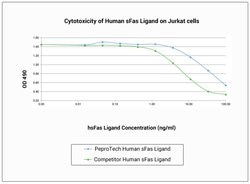Learn More
Gibco™ Human Fas Ligand (soluble) Recombinant Protein, PeproTech®

Description
Recombinant Human soluble Fas Ligand is a 17.9 kDa protein comprising the TNF-homologous region of FasL and contains an 8-residue N-terminal His-Tag. This product is shipped at ambient temperature. For storage, handling and reconstitution information, please see the lot-specific Certificate of Analysis

Specifications
Specifications
| Accession Number | P48023 |
| For Use With (Application) | Functional Assay |
| Formulation | protein with no preservative |
| Gene ID (Entrez) | 356 |
| Molecular Weight (g/mol) | 17.9 kDa |
| Name | Human Fas Ligand (soluble) |
| Quantity | 100 μg |
| Source | CHO cells |
| Regulatory Status | RUO |
| Endotoxin Concentration | <1 EU/ μg |
| Show More |
The Fisher Scientific Encompass Program offers items which are not part of our distribution portfolio. These products typically do not have pictures or detailed descriptions. However, we are committed to improving your shopping experience. Please use the form below to provide feedback related to the content on this product.

